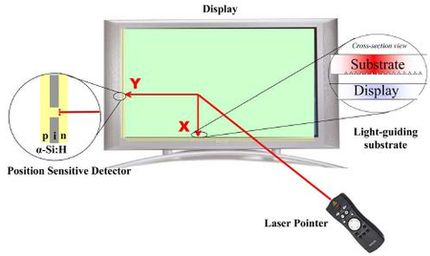March 6, 2008 feature
Laser remote makes watching TV even lazier

Modern-day remote controls can be complicated. But, thankfully, researchers are making TV the relaxing, mindless pastime that it was always intended to be with a new easy-to-use remote control. The controller is a laser pointer, which can be pointed at different options on a TV screen or other large display to control volume, channels, and make other selections.
As researchers Donato Pasquariello, Gilles Vissenberg, and Galileo Destura explain in a recent issue of the Journal of Display Technology, the laser pointer takes advantage of the intuitiveness of a touchscreen display, but with a longer range. The team is from the Philips Research Laboratories in Eindhoven, The Netherlands.
The system, called “Remote-Touch,” involves three main components: the laser pointer, a micro-structured substrate that fits over the display, and position-sensitive photodetectors at the edge of the display.
“The main advantage is that it is easier and more intuitive to point at objects on the screen, instead of scrolling through a menu via buttons on a remote control or via a mouse or joystick,” Vissenberg told PhysOrg.com.
When a user wants to change a setting, they point the laser at one of the objects on the screen. Placed over the screen is a transparent substrate made of polymethyl methacrylate (PMMA) with small pyramid-shaped indentations on the backside of the substrate. The pyramids, which have a base of about 50 x 50 micrometers, are designed to “capture” part of the incoming laser beam when a user “clicks” on certain points.
“The signal for the selection-click can be sent by a conventional remote control signal and then be linked to the coordinates of the laser pointer, or it can be incorporated by a modulation in the laser pointer signal itself,” Vissenberg explained.
Then, the four facets of the pyramids reflect the light in four directions: up, down, left, and right. Position-sensitive photodetectors (PSDs) located at the edges of the display detect the light at the appropriate x- and y-coordinates, determining which object on the screen was pointed at. The output of the PSD is directly linked to the TV chip. Or, if used to remotely control a computer, the laser pointer coordinates could be used as mouse coordinates, Vissenberg explained.
The researchers built a prototype of the remote-touch feature on a 21” LCD screen, using a laser pointer with a wavelength of 780 nanometers for pointing. They also developed a correction method for laser beams that were aimed at the screen from a wide angle, enabling the method to work accurately even when viewers were sitting off to the side of the screen.
The group hopes that this technique could offer an inexpensive alternative to touchscreen and other control techniques. The most commonly used touchscreen technology, called resistive touchscreen, is limited to a maximum screen size of 21”. The only option for larger screens is infrared touchscreen technology, which is very expensive. Because of its low-cost materials, the Remote-Touch concept could offer an inexpensive alternative to conventional touchscreens of any size.
More information: Pasquariello, Donato, Vissenberg, M. C. J. M., and Destura, Galileo June. “Remote-Touch: A Laser Input User-Display Interaction Technology.” Journal of Display Technology, Vol. 4, No. 1, March 2008.
Copyright 2008 PhysOrg.com.
All rights reserved. This material may not be published, broadcast, rewritten or redistributed in whole or part without the express written permission of PhysOrg.com.





















